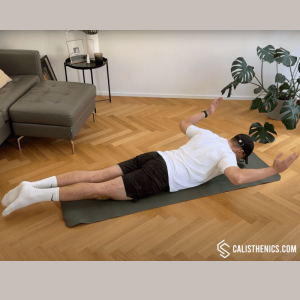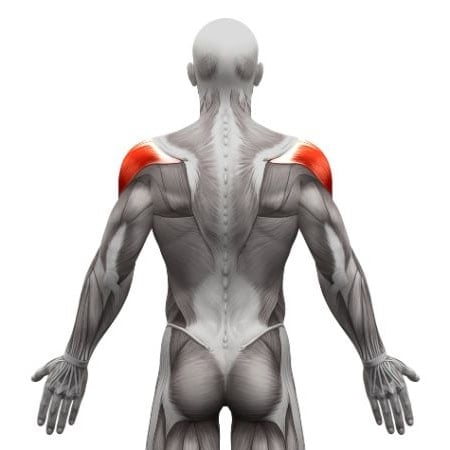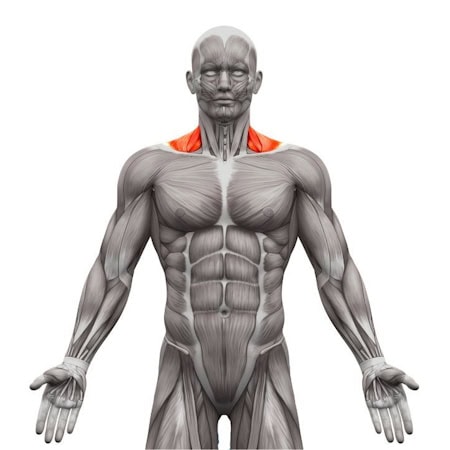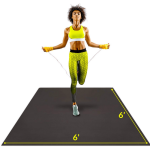WTY Raises
How to do WTY Raises?
WTY raises are a bodyweight exercise focused on strengthening the muscles of the upper back, shoulders, and improving posture. The exercise involves forming the letters “W,” “T,” and “Y” with your arms while lying face down on the ground. This movement targets the scapular stabilizers, rotator cuff, and other muscles responsible for shoulder mobility and upper back strength, making it ideal for correcting posture, especially for those who sit for long periods or suffer from rounded shoulders.
Steps to Perform a Proper WTY Raise:
1. Starting Position (Prone):
• Lie face down on a mat with your legs extended straight and your arms resting by your sides. Keep your forehead gently resting on the mat or hover slightly above it, maintaining a neutral neck position.
• Keep your core and glutes engaged to maintain proper body alignment throughout the exercise.
2. W-Raise:
• Start by lifting your arms and elbows off the ground, creating a “W” shape with your arms. Your elbows should be bent at 90 degrees, with your palms facing the ground and your upper arms in line with your shoulders.
• Squeeze your shoulder blades together as you lift your arms, focusing on engaging your upper back muscles.
• Hold the position briefly, then lower your arms back down in a controlled manner.
3. T-Raise:
• Extend your arms out to the sides to form a “T” shape with your body, keeping your arms parallel to the ground and your palms facing down. Your arms should be in line with your shoulders.
• Lift your arms off the ground, squeezing your shoulder blades together. Keep your arms straight and your chest slightly lifted to maximize upper back engagement.
• Hold briefly, then lower your arms back down with control.
4. Y-Raise:
• Extend your arms overhead in a “Y” shape, with your thumbs pointing up toward the ceiling and your arms at an angle from your body.
• Lift your arms and chest off the ground, focusing on squeezing your shoulder blades together and engaging your upper back and shoulders.
• Hold for a moment at the top of the movement, then lower your arms back down slowly.
5. Repeat the Sequence:
• Perform the W, T, and Y raises in sequence for the desired number of repetitions, focusing on controlled movements and proper shoulder engagement throughout.
Benefits of WTY Raises
• Strengthens the Upper Back and Shoulders: WTY raises target the upper back, shoulder stabilizers, and rotator cuff muscles, helping to build strength and improve shoulder mobility.
• Improves Posture: This exercise helps correct rounded shoulders and poor posture caused by prolonged sitting or working at a desk, strengthening the muscles that support good posture.
• Enhances Shoulder Mobility and Stability: By targeting the smaller stabilizing muscles around the shoulder joint, WTY raises improve shoulder mobility and reduce the risk of injury, especially in athletes and those who perform overhead movements.
• Relieves Upper Back Tension: Strengthening the muscles of the upper back can help reduce tension and pain caused by slouching or poor posture.
• Low Impact: This exercise is gentle on the joints and can be performed by individuals of all fitness levels, including those recovering from shoulder injuries or looking to improve shoulder mobility.
• Prevents Shoulder Impingement: By strengthening the rotator cuff and scapular stabilizers, WTY raises help reduce the risk of shoulder impingement, making them a great preventative exercise for athletes or individuals prone to shoulder pain.
Common Mistakes to Avoid
• Lifting the Head: Keep your neck in a neutral position by looking down at the ground. Avoid lifting your head too high, which can strain your neck.
• Using Momentum: Focus on controlled, slow movements rather than relying on momentum to lift your arms. This ensures that the correct muscles are being activated.
• Arching the Lower Back: Keep your core and glutes engaged to avoid overextending your lower back. Lifting too much from the lower back can cause strain and reduce the effectiveness of the exercise.
• Shrugging the Shoulders: Avoid shrugging your shoulders toward your ears during the lifts. Focus on squeezing your shoulder blades together to engage the correct muscles.
Tips for the proper execution of WTY Raises
Core and Glute Engagement: Keep your core and glutes engaged throughout the exercise to support your lower back and maintain proper body alignment.
Focus on Shoulder Blades: The key to WTY raises is squeezing your shoulder blades together during each raise to engage the muscles of the upper back.
Control the Movement: Perform each raise slowly and with control, avoiding any jerky movements. Focus on quality over speed.
Neck Alignment: Keep your neck in a neutral position by looking down at the floor. Avoid lifting your head too high, which could strain your neck.
Breathing: Inhale as you prepare to lift your arms and exhale as you squeeze your shoulder blades together and raise your arms. Steady breathing helps maintain control and focus.
Muscles worked when doing WTY Raises
Primary Muscles:
•Upper Back: Rhomboids and trapezius muscles (engaged to squeeze the shoulder blades and stabilize the scapulae).
•Rotator Cuff: Infraspinatus, teres minor, and supraspinatus (support shoulder stability and mobility during the movement).
•Deltoids: Posterior deltoids (rear shoulders engaged in lifting the arms).
Secondary Muscles:
•Lower Back: Erector spinae (engaged to support body alignment and prevent rounding).
•Core: Abdominals help stabilize the torso throughout the exercise.
•Glutes: Engaged to help maintain lower body stability and reduce strain on the lower back.
Primary Muscle(s):
Secondary Muscle(s):
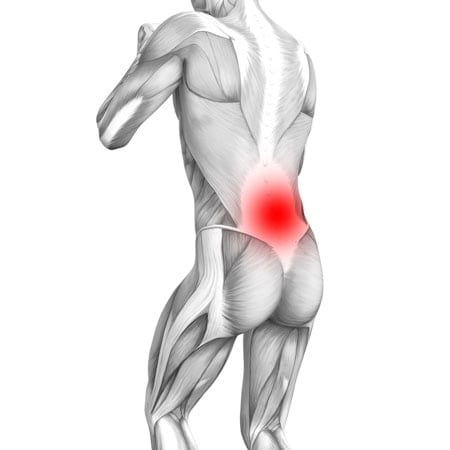
Lower back
Adjust the difficulty of WTY Raises
How to make WTY Raises harder?
How to make WTY Raises easier?
How to make WTY Raises harder?
To make WTY Raises harder:
-
Add Light Weights: Hold small dumbbells or water bottles (1-2 lbs) in your hands during the raises to increase resistance and further engage your shoulder and back muscles.
-
Increase Repetitions or Sets: Perform additional repetitions or sets to challenge your endurance and build more strength in your upper back and shoulders.
-
Hold for Longer at the Top: Pause for 3-5 seconds at the top of each raise (W, T, and Y) to increase time under tension and further engage the upper back muscles.
-
Use Resistance Bands: Attach a light resistance band around your wrists and perform the WTY raises while pulling against the band, adding extra resistance to the movement.
How to make WTY Raises easier?
To make WTY Raises easier:
-
Perform One Shape at a Time: Instead of performing the entire WTY sequence in one set, focus on just one movement at a time, such as W-raises, to reduce the intensity.
-
Lower the Range of Motion: If you’re new to the exercise, start with a smaller range of motion, lifting your arms only slightly off the ground, and increase the range as you gain strength and control.
-
Support the Chest: Place a small towel or cushion under your chest to provide slight elevation and support if you find it challenging to lift your upper body.

